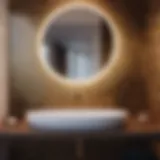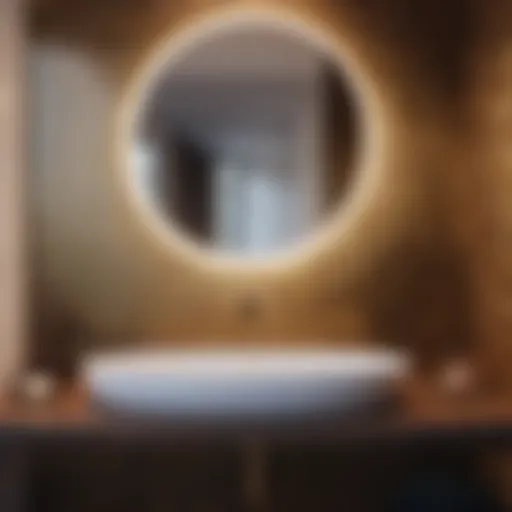Exploring Wood Look Bird Baths: A Complete Guide
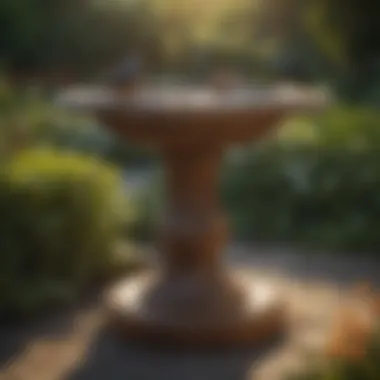

Intro
Bird baths have long been a beloved addition to gardens and yards, serving not just as a source of water for our feathered friends, but also as stunning ornamental features that enhance the beauty of outdoor spaces. Among the various styles available, wood look bird baths offer a rustic charm that complements any landscape. These artistic features mimic the texture and tone of natural wood, combining durability with aesthetic appeal. In this comprehensive guide, we’ll explore everything from materials needed to the step-by-step process of creating and installing these delightful installations. Whether you're a dedicated birdwatcher or a gardening enthusiast, you will find this guide beneficial in understanding how to integrate these stunning features into your outdoor environment.
Materials:
Creating a wood look bird bath starts with gathering the right materials. Below is a detailed list to assist you in the planning phase. Selecting the right materials can significantly impact the durability and appearance of your bird bath.
- Pressure-treated wood boards: 2 pieces 2x4 inches, each about 4 feet long (for the base frame)
- Wood for the basin: 1 piece 1x6 inches, 3 feet long, plus 2 pieces 1x4 inches, each 4 feet long
- Waterproof sealant: 1 quart (to protect wood against moisture)
- Wood screws: 2 1/2 inches and 1 1/4 inches (for assembly)
- Bird friendly non-toxic paint: Optional for finishing
- Landscape fabric: 1 small roll (to line the basin)
- Concrete mixing bag: 1 small (for stability)
This selection ensures you not only achieve the desired look but also create a long-lasting piece.
Detailed Instructions:
Step 1: Preparing the Base Frame
Start by measuring and cutting your pressure-treated wood boards according to the plans. Join the two longer pieces with two shorter pieces using 2 1/2-inch wood screws, forming a rectangular base. Make sure everything is square and secure. You can use a drill for this, as it could save you some effort.
Step 2: Constructing the Basin Frame
Using the 1x6 wood piece, carve out a circular basin. This will hold the water and attract birds. Create a larger diameter to allow different species to access it. Secure the basin using 1 1/4-inch screws and attach the 1x4 guides around the edges for added support.
Step 3: Sealing and Painting
Once assembled, apply the waterproof sealant generously to all exposed wood. This step is critical to ensuring your bird bath withstands the elements while remaining safe for birds. If you opt to paint, make sure to use bird-safe, non-toxic paint for color.
Step 4: Pouring Concrete
Assemble the frame in your chosen location and mix the concrete. Pour it into the base, ensuring it levels and sets the structure firmly in place.
Step 5: Final Touches
After the concrete has fully cured (usually around 48 hours), install the landscape fabric in the basin to provide a non-slip surface for the birds. Make sure to leave some gaps to allow for water drainage.
"Using proper materials not only enhances the appearance of your bird bath but ensures that it stands the test of time."
Technical Aspects:
Before you jump into the DIY process, let’s discuss some technical aspects that can affect the outcome of your wood look bird bath:
- Tools Required:
- Timing:
- Critical Techniques:
- Power drill
- Saw (table saw or circular saw)
- Screwdriver
- Mixing bucket for concrete
- Measuring tape
- Preparation and assembly: Approximately 2-3 hours
- Curing time for concrete: 48 hours
- Sealing and drying: Allow 24 hours before using
- Ensure cuts are accurate for a clean assembly
- Allow ample drying time for sealants to ensure bird safety
DIY Project Process:
Step 6: Installation Method
After the basin is complete and cure durations are met, place your bird bath in a sunny or partially shaded spot, a good distance from trees to avoid predators. Keep it visible from your window for birdwatching!
Troubleshooting Tips:
- Common Mistake: If you notice water leaking, check the sealant application closely. Leftover gaps must be filled.
- Adjustment: If the bird bath seems too deep for smaller birds, consider raising the basin height slightly or adding pebbles at the bottom to create a shallower option.
By following these steps and techniques, you can create a beautiful wood look bird bath that not only serves the birds but also enhances your garden space.
Foreword to Wood Look Bird Baths
The charm of wood look bird baths blends nature with artistry, serving as eye-catching focal points in gardens across the globe. These installations not only appeal aesthetically but also play a crucial role in attracting birds, thus enriching the ecosystem. As homeowners increasingly seek ways to harmonize their outdoor spaces with the environment, wood look bird baths emerge as a delightful option.
Definition and Overview
At their core, wood look bird baths mimic the appearance of natural wood while often being constructed from synthetic materials. The aim is to provide a rustic yet refined look that can charm any garden. Typically, these baths come in various styles and finishes, allowing for better integration within diverse landscapes. Whether it’s a contemporary patio or a traditional backyard, the versatility of wood look bird baths can cater to various tastes and preferences.
Wood look bird baths serve a dual purpose; they provide hydration for birds while offering a decorative element for outdoor decor. Utilizing materials like resin or fiberglass to achieve this appearance ensures durability and lower maintenance while delivering visual appeal.
Historical Context
Bird baths have a rich history, dating back centuries. They originated from simple water vessels used by ancient civilizations to attract birds for practical and artistic reasons. As gardening practices evolved, so did the designs and materials used in bird baths. Initially made from stone or clay, these installations have transformed over time, paralleling the development of home landscapes.
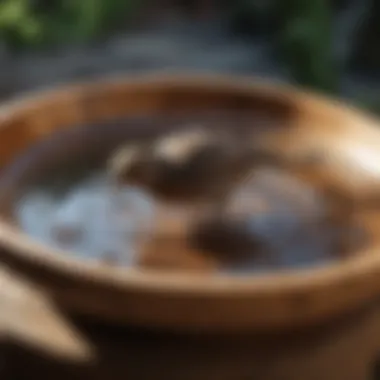

The 20th century saw a surge in interest towards ornamental gardening, coinciding with a growing awareness of conservation efforts. Bird baths became not only functional objects but also expressions of creativity and personal style. Wood look bird baths emerged as a modern solution catering to those who desire both beauty and sustainability in their gardens.
Popularity in Contemporary Gardens
In today’s world, where harmonizing aesthetics with functionality is essential, wood look bird baths have gained considerable traction among garden enthusiasts. Their allure lies in several key factors:
- Natural Aesthetics: Gardens are increasingly being designed to resemble natural habitats. Wood look bird baths blend seamlessly into such environments, enhancing the garden's charm.
- Durability: Unlike real wood, which can be susceptible to rot and weathering, synthetic materials used in these bird baths offer longevity without sacrificing style.
- Wide Range of Options: From sleek modern designs to ornate traditional models, there’s a bird bath for every type of gardener. Homeowners appreciate the variety that allows them to choose a piece that matches their outdoor theme.
As urban gardening rises, the trend reflects a growing longing for nature amidst concrete surroundings. Homeowners wish to cultivate environments that are welcoming not only for themselves but also for local wildlife, making wood look bird baths a natural fit. Overall, the combination of aesthetic appeal, historical significance, and contemporary relevance contributes to the immense popularity of these installations in gardens everywhere.
Material Composition
When it comes to wood look bird baths, material composition is crucial. The choice of materials not only influences the aesthetics and durability but also affects the maintenance and overall functionality of the bird bath. For bird enthusiasts, selecting the right material can significantly enhance the experience of attracting different bird species. This section will delve into material alternatives, comparing the unique benefits and considerations of each option.
Wood Alternatives
Resin
Resin is a popular option for bird baths aiming for that wooden look without the downsides of real wood. One of its significant characteristics is its lightweight yet durable composition. It can withstand the elements, making it a wise choice for outdoor decor.
A unique feature of resin is its resistance to fading and cracking, which often occurs in traditional wooden models over time. This aspect means less hassle when it comes to upkeep, allowing you to enjoy your bird bath without worrying about extensive maintenance. This makes resin a beneficial choice, especially for busy house owners who prefer a more hands-off utility. However, it should be noted that while resin mimics wood beautifully, it lacks the authentic texture and charm that natural wood provides.
Fiberglass
Fiberglass is another material widely used in the crafting of bird baths, known for its robustness and versatility. What stands out about fiberglass is its ability to repel water and resist corrosion, making it particularly suitable for areas with high moisture levels. This characteristic greatly contributes to a longer lifespan for the bird bath.
An interesting unique feature of fiberglass is its ability to be molded into various shapes and designs, closely resembling hand-carved wood. This feature allows for more creative and aesthetic possibilities that can enhance any garden or yard. Nevertheless, some might find fiberglass less appealing due to its artificial look compared to natural wood, and it's important to note that it may not offer the same warmth as its wooden counterpart.
Composite Materials
Composite materials take advantage of modern engineering to create bird baths that offer the best of both worlds: the look of wood and the endurance of synthetic materials. They often combine wood fibers and plastic, which not only minimizes environmental impact but also ensures longevity.
The standout feature of composite materials is their resistance to warping and fading over time—features that are hard to come by with real wood. This makes them an increasingly popular choice for homeowners who want an attractive bird bath that doesn’t deteriorate. However, any disadvantages might include a higher upfront cost, which could be off-putting for some.
Natural Wood vs. Synthetic Options
Choosing between natural wood and synthetic options hinges on several factors such as aesthetics, maintenance, and budget. Natural wood offers a classic beauty and can seamlessly blend into traditional landscapes but requires regular treatment against rot and pests. Synthetic options, while less authentic in feel, offer durability and less upkeep, making them attractive to those who prefer practicality.
In the end, the choice of material should align with your personal values and the functionality you seek from your bird bath.
Design Considerations
The design of wood look bird baths involves more than just aesthetics; it integrates functionality, durability, and a connection to the environment, making it a crucial element for enhancing outdoor spaces. When planning a bird bath, the chosen designs can directly influence how birds perceive and interact with this feature. With careful attention to specific design elements, homeowners can create a welcoming habitat that attracts a diverse range of wildlife and enhances the overall beauty of their gardens.
Aesthetic Variability
Rustic Styles
Rustic bird baths encapsulate a natural charm that can draw attention in any garden setting. These designs often embrace materials that mimic the look and feel of real wood, such as distressed finishes or rough-hewn edges. This aesthetic is popular among garden enthusiasts who favor a casual, organic appearance. The key characteristic of rustic styles is their ability to blend seamlessly into various outdoor landscapes, providing an inviting space for birds while complementing the rugged beauty of nature itself.
A unique feature of rustic bird baths is their often asymmetrical forms, which can evoke a whimsical character. However, a potential disadvantage is that these designs may not always suit more formal or modern gardening styles, potentially leading to a mismatch in overall garden aesthetics.
Modern Interpretations
Modern designs of bird baths lean toward clean lines and minimalist beauty. This approach often utilizes sleek materials, possibly incorporating metal or glass elements alongside wood-like finishes. The key characteristic of modern interpretations is their focus on simplicity, often serving as a striking focal point that draws the eye without overwhelming the surrounding space.
One unique feature here is the innovative incorporation of geometric shapes, which stands out but may sacrifice some traditional charm that many birders love. These modern styles can often fit in well with contemporary homes and gardens but may lack the warm, inviting feel found in more rustic options.
Traditional Designs
Traditional designs reflect a rich history of craftsmanship and are often adorned with ornate details such as carvings or intricate patterns. The key characteristic of these bird baths is their classic appearance, which evokes nostalgia and a timeless quality. A traditional bird bath can serve not only as a functional piece but also as a work of art rather than simply a utility.
One unique feature is how these designs often include motifs inspired by nature, like floral engravings, which provide a deeper connection to the garden as a sanctuary for wildlife. However, on the flip side, traditional styles may require more maintenance and care, given their more intricate designs, and they may not integrate well into more modern or minimalist gardens.
Functional Design Elements
Water Depth and Shape
The water depth and shape of a bird bath are paramount to ensuring that birds can safely bathe and drink. Shallow, gently sloped designs are particularly attractive for smaller birds, while deeper basins might serve larger species. The key characteristic here is how the design facilitates usability while keeping the aesthetic parameters in check. A shallow basin encourages frequent visitation from birds and promotes accessibility.
Unique to this aspect is how varied shapes—like circular, square, or even free-form shapes—can cater to different avian preferences. While appealing, deeper designs may require regular water quality checks, as stagnant water can harbor unwanted bacteria.
Perches and Landing Zones
Perches and landing zones are integral to creating a safe and inviting bird bath. Birds need spaces to rest before entering the water, making these design elements essential. The key characteristic of effective perches is their strategic placement surrounding the bath, allowing birds easy access to water without feeling threatened.
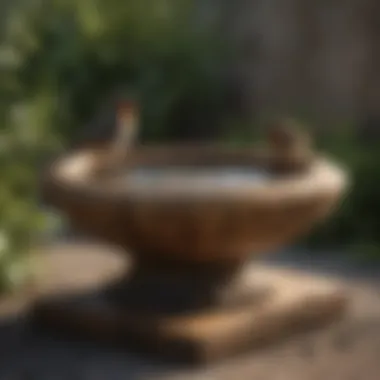

A distinctive advantage is how these elements can encourage a wider variety of birds to visit, as many species require secure spots to land. However, overly complicated structures can deter some birds, emphasizing the need for simplicity and open space.
Drainage Features
Increased functionality is a direct result of incorporating drainage features into bird baths. Effective drainage systems help maintain water cleanliness, preventing stagnation and offering a healthy environment for visiting wildlife. The key characteristic here is how these features contribute directly to ease of maintenance, ensuring that homeowners spend less time cleaning and more time enjoying the birds.
A unique aspect of good drainage design is its ability to adapt to various weather patterns, allowing water to flow away and minimizing any flooding risks. However, a potential drawback can be if not designed properly, resulting in water loss too quickly, deterring birds from returning.
"Crafting a bird bath is as much about creating a habitat as it is about enhancing the aesthetics of your garden."
In summary, thoughtful design considerations in wood look bird baths bring together elements of beauty and utility. By carefully selecting styles and functional features, homeowners can curate welcoming environments for birds while enriching their outdoor spaces.
Installation Methods
Understanding the installation methods for wood look bird baths is crucial for several reasons. First off, laying a solid foundation ensures that the bird bath is stable and safe for visiting wildlife. Inclement weather or an unsteady setup can easily tip over these ornamental baths, turning them from a welcome haven to a hazard. Proper installation methods not only enhance the aesthetics by ensuring a polished look but also maximize the longevity of the bird bath, preserving its beauty and functionality over time.
Site Selection
Choosing the right spot for your wood look bird bath is nearly as important as the bath itself. Birds are quite particular about their environment, so your selection should align with their preferences. Ideally, you want to place the bird bath in a shaded area, especially in warmer months. This keeps the water cooler and more inviting. At the same time, ensure it's visible from your home; a good view can enhance both your enjoyment and observation of local wildlife.
Make sure the location is moderately sheltered. A few nearby branches or shrubs can give birds a safe space to perch before diving into the water. Too much openness might leave them vulnerable to predators. Mark the spot where you intend to install the bath and take a moment to watch how birds interact with the area before committing. If they’re flying over or avoiding it, that could be a sign that this site might not be ideal.
Base Preparation
Once you’ve settled on the right location, the next logical step is base preparation. This phase frequently gets overlooked but is arguably the backbone of a successful installation. A level surface prevents tipping and encourages stability. If your selected area is uneven, it's wise to dig out a bit and level it out. This might not seem like much, but a few inches can mean the difference between a functional bird bath and a disaster waiting to happen.
After leveling, the next step involves laying down a solid base. You can use gravel, paving stones, or even sand. Each option has its pros and cons: gravel allows for drainage while paving stones can add extra charm to the setting. Whatever you choose, the base area should be large enough to be stable but not so large that it detracts from the aesthetic beauty of the bird bath.
Securing the Bird Bath
Now that you’ve got the base set, securing the bird bath is the final stage. Depending on the style and material of your bath, you have various options for ensuring it remains upright.
- If your bird bath comes with a pedestal, you can either dig a shallow hole to firmly seat the pedestal or use a strong adhesive designed for outdoor use.
- For a bowl-style bird bath that rests directly on the ground, ensure it’s snugly fitting into the prepared base to prevent movement.
A touch of extra protection can never hurt. Consider using landscape fabric around the base to inhibit weed growth while also securing the bird bath. Adding a few rocks around the edges can further enhance stability and give it a natural feel.
"Dedication to the proper installation ensures that you and your feathered friends can enjoy the bird bath for years to come."
In summary, taking the time to thoughtfully select the site, prepare a solid base, and secure the bath will lead to a bird watching experience that is both delightful and fulfilling. This careful yet straightforward installation process transforms not just your garden aesthetic but also the joyful interactions between nature and your culinary creations.
Maintenance Requirements
Taking care of your wood look bird bath goes beyond just admiring its beauty. Regular maintenance ensures it remains a safe haven for birds and an appealing feature in your garden. Without proper upkeep, algae can grow, surfaces may deteriorate, and the overall aesthetic can be compromised. Let’s break down the essential aspects of maintaining these elegant garden fixtures, focusing on cleaning protocols and protective measures.
Cleaning Protocols
Frequency and Techniques
Cleaning your bird bath regularly plays a crucial role in promoting a healthy environment for visiting birds. Ideally, it should be cleaned at least once a week, especially in warmer months when algae bloom and debris accumulates quickly.
One effective technique is using a soft brush and a mixture of vinegar and water. This combo not only cleans but also disinfects, killing harmful bacteria without being harsh on the materials. Some folks may prefer chemical cleaners, but natural solutions like this are safer for the wildlife.
A key characteristic of this method is simplicity; it doesn’t require fancy tools or extensive knowledge. It’s a beneficial choice for maintaining your bird bath's integrity while ensuring that the birds are not exposed to potentially harmful residues.
However, it’s crucial to be diligent to avoid taking shortcuts. A unique advantage of adhering to this frequency and technique is the prevention of deeper stains or permanent damages, which can arise if neglected.
Removing Algae and Debris
As outdoor structures, bird baths can quickly gather fallen leaves, dirt, and algae, particularly with the convenience of nearby trees. Thus, regular removal of algae is essential for two main reasons: aesthetics and bird safety. The buildup can deter birds from using it, meaning your beautiful addition may not serve its purpose.
To remove algae and debris, first, drain the water and gently scrub the surfaces with a stiff brush. Focusing on those stubborn spots where algae cling requires a bit more elbow grease, but the outcome is worth it. Additionally, let the bath dry out completely before refilling it; this helps kill off any remaining algae spores.
Removing visible debris like leaves or twigs daily can be tempting, but don't overlook the task of thorough scrubbing. The beauty of this approach lies in its effectiveness at maintaining not only cleanliness but hygiene—a crucial aspect for any bird-friendly space.
Protective Finishing Techniques
To keep your bird bath looking good as new through various weather conditions, investing in protective finishing techniques is indispensable. This involves using materials that enhance longevity and maintain the visual appeal.
Sealants
Sealants are a smart choice that can greatly prolong the life of your bird bath. These products create a barrier that protects against moisture, ensuring that your structure doesn’t absorb water and swell over time. Applying sealant once a year can ward off cracking and fading, giving your bird bath a longer lifespan.
The unique feature of sealants is their ability to prevent mold growth, which can become a troublesome issue. A downside, though, is that you must ensure you apply it properly. Any mistakes can lead to undesirable results like peeling or an uneven finish, so carefully following the manufacturer's instructions is key.
Weatherproofing Solutions
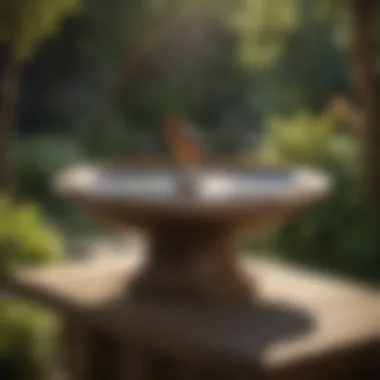

Weatherproofing solutions serve as your first line of defense against nature's elements—rain, sun, and even snow. These solutions protect your bird bath from cracking due to frost or fading due to prolonged sun exposure.
Using a weatherproof finish highlights the durability of your bird bath. This can be particularly beneficial in areas with extreme weather. However, remember that weatherproofing may need reapplication over time, especially if it faces harsh conditions. Regular checks will help you gauge its effectiveness and decide when to reapply.
In summary, understanding and applying maintenance requirements is essential for preserving the beauty and function of your wood look bird bath. By keeping up with cleaning routines and employing protective measures, not only do you enhance its longevity, but you also create a welcoming environment for birds, ensuring consistent visits that can liven up your outdoor space.
Ecological Impacts
Understanding the ecological impacts of incorporating wood look bird baths into your garden reveals significant benefits that extend beyond personal enjoyment. These decorative features play an integral role in attracting wildlife and supporting local ecosystems, while also raising important sustainability considerations. By evaluating each of these aspects, homeowners can make informed decisions that favor the environment and enhance their outdoor spaces.
Attracting Wildlife
Beneficial Bird Species
When you install a wood look bird bath, you open your yard to a myriad of beneficial bird species. What’s particularly interesting is how these birds can enhance your garden's ecosystem. For instance, classic songbirds like the American Robin or Northern Cardinal not only contribute to the cheerful ambiance but also naturally keep pests in check, munching through insects and establishing a balance.
A key characteristic of these birds is their preference for environments that offer both water and feeding stations. Their unique feature lies in their adaptability; they tend to gravitate towards areas where they can find food and hydration with ease. By placing a bird bath in your garden, you’re providing a critical resource particularly during droughts when natural water sources may dwindle. This, in turn, bolsters the local population of these beneficial species.
Moreover, having a variety of these birds can attract more species due to increased activity, enhancing the biodiversity of your garden. However, it’s worth noting that some species may scare off others; for example, larger birds may dominate feeders and baths, leading to competition for resources among smaller songbirds.
Supporting Local Ecosystems
Installing bird baths supports local ecosystems in multiple ways. One important aspect is creating a microhabitat that encourages a healthy mix of flora and fauna in your garden. Over time, a well-maintained bird bath can attract insects, which serve as a food source for birds, while also aiding in pollination for your plants. For instance, bees may become drawn to your garden while attracted to the butterflies it hosts, establishing a bustling ecosystem.
A striking feature of this is how interconnected life forms can flourish through this simple addition. Not only do birds depend on the water source for survival, but the plant life and soil organisms also benefit from the natural processes set into motion by bird activity. From spreading seeds to aiding in pest control, birds contribute directly to the health of their ecosystems. Ultimately, a wood look bird bath becomes more than just an aesthetic element—it's a vital part of sustaining ecological harmony.
Sustainability Considerations
Environmental Footprint
As you consider installing a wood look bird bath, examining its environmental footprint becomes essential. This term refers to the amount of natural resources consumed and the waste produced during the lifespan of the product. Choosing bird baths made from eco-friendly materials significantly reduces your garden's overall impact on the planet.
For instance, selecting a bird bath crafted from recycled materials minimizes the need for new resources and curtails waste. Such products often balance visual appeal with responsible sourcing. Accordingly, this choice aligns with broader environmental goals and reflects a commitment to sustainability, proving to be a popular route for environmentally conscious homeowners.
However, keep in mind that the craftsmanship of these products can vary. Low-quality bird baths might wear down quickly, leading to a need for replacements that contribute to increased waste. Being mindful about quality alongside sustainability aids the goal of a smaller environmental footprint.
Sourcing Sustainable Materials
When it comes to sourcing sustainable materials for your bird bath, local options often provide the best routes towards minimizing your ecological impact. When materials are harvested and processed within close proximity, it significantly reduces transportation emissions, making it a more environmentally friendly choice.
The key characteristic of sustainable materials is their renewable nature. For example, bamboo is a great option; it grows rapidly and can be harvested without compromising the environment. Some manufacturers are now exploring innovative ways to repurpose wood scraps from construction and furniture making for these decorative items, aligning with a circular economy approach.
This unique feature of utilizing sustainable materials presents a double-edged sword. While the benefits of reducing environmental impacts are clear, some materials may lack the durability and longevity needed for outdoor use, making careful selection critical. In this regard, being diligent about the quality and sourcing of your bird bath can elevate its practicality as well as its appeal.
Innovations and Trends
When we look at the ever-evolving world of garden decor, particularly wood look bird baths, there's a wealth of innovations reshaping how we engage with these delightful outdoor features. These shifts not only reflect aesthetic desires but also address practical concerns, thus enhancing the overall experience of both birds and bird watchers. Understanding these trends is key for homeowners who wish to create inviting spaces with these pieces.
Smart Bird Baths
In recent years, technology has made its way into bird care. Smart bird baths, equipped with advanced features, are becoming increasingly popular. One crucial element of this trend is the incorporation of solar-powered pumps that keep the water circulating. This movement of water not only attracts birds but also prevents stagnation, which is essential for maintaining a healthy environment for your feathered visitors.
Moreover, smart bird baths can include sensors to monitor water levels, alerting you when it’s time to refill. Some of them even have built-in water heaters for those chilly winter months. Imagine being alerted on your smartphone to ensure your bird bath is always ready, rain or shine!
Artistic Collaborations
Artistic collaborations are another exciting trend redefining the landscape of bird baths. These pieces are not merely functional but serve as stunning works of art. Designers often partner with local artisans or landscape architects to create unique designs that reflect the surrounding nature, making the bath a centerpiece rather than an afterthought.
In this context, materials like ceramic, glass, or even reclaimed wood can come together to form visually striking bird baths that speak to the homeowner's values of sustainability and creativity. Furthermore, such artistic collaborations can support local economies while fostering a sense of community pride in garden aesthetics.
To sum up, the innovations and trends seen in wood look bird baths represent a notable shift toward combining functionality with artistry. With smart technology enhancing usability and artistic designs elevating outdoor aesthetics, there’s never been a better time to explore how these trends can breathe new life into your garden.
End
Summarizing the journey through the intricacies of wood look bird baths reveals their significance in enriching outdoor spaces while enhancing our connection to nature. This guide emphasizes that these artistic installations serve not just as decorative elements, but also as functional habitats for wildlife.
Reiteration of Benefits
First and foremost, wood look bird baths effectively attract a myriad of bird species, turning your garden into a vibrant hub of life. With the right setup, you can expect to see everything from blue jays to finches enjoying the water. Besides their aesthetic appeal, they promote biodiversity by offering essential habitats in urban and suburban areas where natural spaces are dwindling.
Incorporating one into your garden also provides an opportunity for relaxation. Imagine sitting in your backyard, sipping tea, while flocks of winged creatures flit about, creating a dynamic atmosphere. This kind of interaction fosters a sense of tranquility, making outdoor spaces more inviting.
Moreover, the maintenance and care involved in owning a bird bath create a fulfilling hobby. Regular cleaning and filling encourage a deeper engagement with your environment, leading to increased appreciation for nature.
Future Prospects
Looking ahead, the evolution of wood look bird baths is promising. As technology and design paradigms shift, we can expect to see more innovative features integrated into these installations. For instance, advancements like solar-powered heaters or smart sensors could become commonplace, ensuring optimal conditions for birds throughout the seasons.
Sustainability is another crucial concern. Increasing awareness about environmental issues may lead to a surge in the demand for eco-friendly materials. Expect manufacturers to invest in sustainable sourcing practices that minimize hurt to our ecosystems. Collaborations with local artisans and designers might also bring a fresh batch of creative ideas to the table, blending ecological responsibility with artistic expression.
By considering the benefits and staying attuned to emerging trends, homeowners can foster unique outdoor environments that serve the dual purpose of beautifying their spaces and supporting local wildlife. Whether you are an avid bird watcher or simply enjoy the beauty of gardens, wood look bird baths are foundational features worth exploring.






